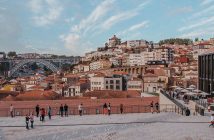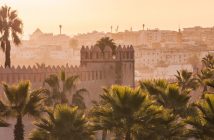I’m sitting on the terrace of the Almyra Hotel talking to Christos Patsalides, Chairman of Pafos2017. He’s telling me how Paphos came to be chosen as next year’s European Capital of Culture. It may be the smallest city ever to have been granted the honour, Christos says, but what won the day was its dazzling array of cultural possibilities.
I nod absently. It’s mid-October here in Cyprus, but it’s 30 degrees in the shade. The hotel’s infinity pool laps above a vista of endless Mediterranean. Squadrons of staff wait discreetly in the wings. Behind the pool bar, I see bottles of Keo – Cyprus’s Czech-inspired local pilsner – glistening in the glass-fronted fridge. The temptation to stay put is overwhelming, but I force it from my mind and get to my feet.
The streets outside the hotel are somewhat underwhelming. Cyprus’s colonial past brings many small advantages to the British traveller. Left-hand driving. UK power points. But the plethora of ersatz pubs and sports bars that dominate parts of Paphos may not be to everyone’s taste.

Not to be daunted, however, I press on towards the Archaeological Park. In addition to sun, sea and sand, Paphos is celebrated for being the mythological birthplace of Aphrodite. There’s a rock a few miles up the coast upon which the goddess is said to have risen from the surf – Botticelli substituted a shell for the rock, but you get the picture. The town’s romantic motif has long made it a favourite destination for weddings. No less an Adonis than Paul Hollywood got hitched here – indeed, one of his first jobs in baking was at the Almyra’s sister hotel in Paphos, The Annabelle. The quality of the miniature pains-aux-raisins I enjoyed for breakfast this morning would suggest that the Hollywood legacy endures.
Surprisingly, the Archaeological Park isn’t centred around artefacts of Aphrodite, but a series of beautiful Roman mosaics. In Roman times, Paphos was chosen as Cyprus’s capital, as it was the nearest port to the trading posts of Egypt. Destroyed by earthquakes, the ancient city was concealed until a farmer accidentally unearthed a corner of mosaic on his land in the 1960s. He made the mistake of telling the authorities, after which mosaic upon mosaic was uncovered – the elaborate flooring of a series of sumptuous Roman villas. The farmer’s land was compulsorily purchased, but I was told there’s still a house in the park that’s inhabited, belonging to a recalcitrant old woman. Given the wonderful sea view, and the chance to wander the mosaics uninterrupted of an evening, you can understand her reluctance to move.

I leave the park and head for the Old Town. Paphos has just received 25 million euros from the European Commission to assist in its preparations for next year, and the gold-starred flag flies high. All around are signs of the city being spruced up for its starring role. The JCBs, and men in hardhats, make it hard to see much of the old colonial buildings, but I do spy a huge Roman theatre in the process of excavation; then, on a street corner, a newly-discovered tomb surrounded by railings. Everywhere you dig in this city, it seems, ruins lie beneath. I wonder if they’ll have things ready for the opening ceremony in January.
Feeling a little hot, I retreat to the hotel. Some downtime at the Almyra’s excellent spa; a plate of delicious mezze at the Ouzeri restaurant. A good night’s sleep soothed by the murmur of the sea.
The next morning, I decide to broaden my definition of culture. By day, Georgios Kassianos is Operations Manager of the Almyra; by night, he writes wine columns for the Cyprus Mail and TimeOut Cyprus. As we drive into the mountains above the city, Georgios tells me a bit about Cypriot winemaking. In the 1980s, Cyprus was the world’s 7th largest producer of wine, bottling some 300 million litres a year, most of which was exported to the Soviet Union. But when Communism collapsed, so did Cyprus’s wine industry. Now all that remains is a series of small independent wineries, 18 of which lie conveniently in the hills around Paphos.
We stop off at the Tsangarides Winery. The surrounding countryside resembles something from the Holy Land – rocks, thornbushes. We’re just a twenty-minute plane ride from Lebanon, Georgios reminds me. I wonder how the vines can grow here. ‘They like the stress,’ George replies as we install ourselves beneath a shady, vine-covered pergola.
Angelos, the owner, appears with a succession of local wines. The whites are delicious – crisp and dry, with a hint of tropical fruit. Georgios is happy; so am I.
On the way back, we detour to a local halloumi producer. Maria keeps a flock of 600 goats, and she’s made her latest batch of cheese this morning. She cuts me a slice and the taste is sensational, completely unlike our supermarket version – soft and warm, with pockets of salt as yet unabsorbed. That curious squeak on the front tooth.

Back at the Almyra, I leaf through the Pafos2017 brochure. There’s going to be a theatrical performance amongst the mosaics, I note. Paphos Castle, visible from the hotel, will host the Berlin Philharmonic’s ‘Concert for Europe’, livestreamed around the world. Many of the 350-odd events taking place over the year will focus on local gastronomic specialities. I could come back here, I find myself thinking.
One picture catches my eye. A rusting cargo ship wedged on the rocks beside a network of sea caves. I ask the hotel concierge about it, and she advises me to head there for supper. You won’t regret it, she promises intriguingly.
I follow her directions along a coastal road flanked by tropical banana plantations. I see signs for the Aphrodite Waterpark, the Venus Rock Golf Resort. To my left runs Lara Bay, a long sandy beach where Green and Loggerhead turtles come each summer to breed, perhaps lured by Aphrodite herself.

At last I find the wreck. Behind it is a taverna. It was just a shack before the ship ran aground in 2011, the owner, Andreas, explains. But then business started to boom. There’ll be an event here next year, Andreas promises – a stage lowered into the sea as spotlights play on the ruined ship behind.
Beside the wreck, a pair of newlyweds are posing for photos. Unusual choice of backdrop, I think, but maybe they’re making a statement. Aphrodite will see us through. Love conquers all. There’s some Tsangarides wine on the menu, I note. I order a glass, and a plate of stuffed vine leaves, and sit back to watch the sun set over Egypt. This place has got to me after all.
A member of Design Hotels, Almyra offers a laidback and elegant take on Mediterranean luxury with rates starting from €104 per person, per night including breakfast. ‘Grand Dame’ hotel the Annabelle was the first ever five star hotel to open in Pafos and rates €86 per person, per night (low season), €130 per person per night (high season). For more information, visit www.thanoshotels.com.
For details about news and events to mark Paphos as European Capital of Culture 2017, visit www.pafos2017.eu.
Monarch operates flights to Paphos from Birmingham and London Gatwick airports with fares, including taxes, starting from £69 one way (£136 return).




